Project Dimesioning with LibreCAD
Apr 02, 2012
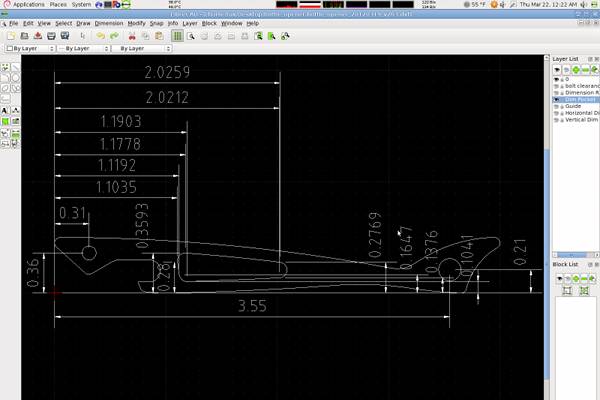
Product Design with FreeCAD
Apr 02, 2012
Originally drawn using a commercial CAD software. Redrawn with LibreCAD, v1.0.1, then finally with FreeCAD v.12-5382, on Debian (Squeeze) GNU/Linux. It was like relearning CAD because a lot of tools are missing from both packages. For example, in FreeCAD there are no tools for specifying tangential relationship between curves. However, the tangential relationship can be established indirectly through parallel lines that are tangential to the curves. Once feature of FreeCAD is it automatically test to see if the sketch is properly constrained. The part looks bigger than actual size. The actual size is ~4" x 0.5" x 0.1". The material is 304 stainless. The next step is to write the gcode and machine the actual product. Followed by laser marking with CerMark.
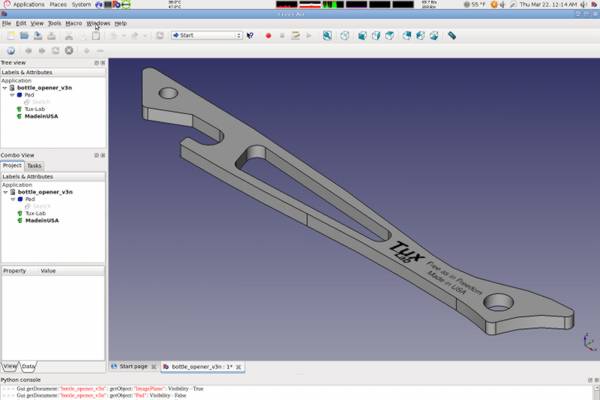
Tux-Lab Rails Upgrade
Apr 02, 2012
Expanded project to allow for simple documentation and tracking function. To boost performance, the default setting for the paperclip gem were changed to convert and save images in jpeg format with a 70% compression quality and stripping away the EXIF information.
Preliminary test on the HaasTec 2011 photo gallery shows a reduction from a total file size of 1.4Mb down to 0.4Mb. The paperclip option used to change the default imagemagick file conversion is,
has_attached_file
:project_image, :styles => { :thumbnail => ["100x67#", :jpg], :sm_thumbnail => ["50x34#", :jpg] },
:convert_options => { :thumbnail => "-quality 70 -strip", :sm_thumbnail => "-quality 70 -strip" },
Finally, a TIG cart
Mar 30, 2012
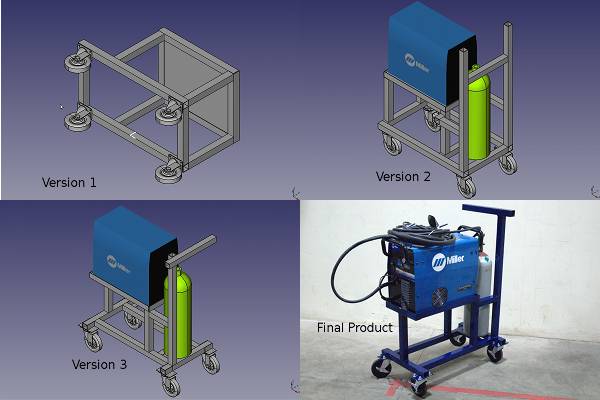
Amazingly most of the tools used were made in democratic countries.
Miller SP175+ MIG Welder - Made in USA
3M SpeedGlas Welding Helmet - Made in Sweden
Metabo Angle Grinder - Made in Germany
Milwaukee Chop Saw - Made in Taiwan
Open Source Desktop
Feb 17, 2012
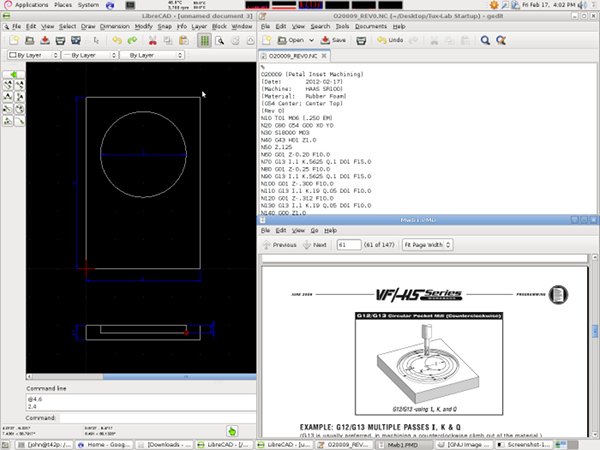
Screenshot of Tux-Lab's typical open source manufacturing desktop. CAD program to left side for dimensional references. Gedit to the upper right for writing g-code. PDF reader to the bottom right for g-code references.
Nothing fancy. Just simple open source tools at the origin.
FreeCAD on Debian
Feb 13, 2012
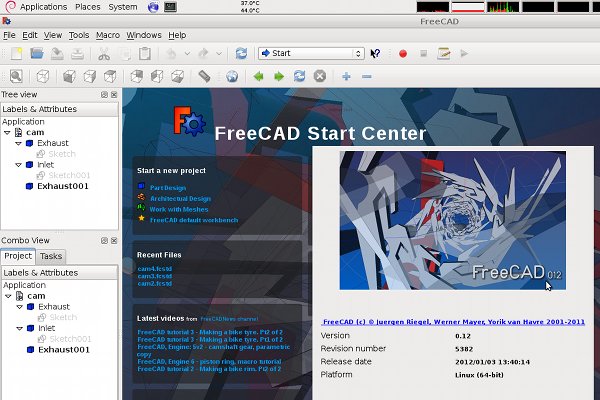
Wow! FreeCAD v.12 is an amazing open source CAD software with a many many future possibilities, but FreeCAD v.12 is only available under Debian Wheezy(Testing). The current FreeCAD version for Debian Squeeze(Stable) is v.10 which is not quite as good as v.12.
Installing Debian Wheezy(Testing) has it's own problems. The Gnome3 desktop was a bit strange, but worst of all is that Wheezy no longer support older NVidia video cards. Installing over a cache-less 512Kb DSL was painfully slow and at the end, Wheezy was not a workable solution with the existing hardware. Returning to Debian Squeeze(stable) was another painfully slow net-install process.
After the 48 circular detour, was all else failed, it was time to read the FreeCAD documentation. As it turned out, the compiling process was not as painful as imagined but slightly different from documented.
Using git or svn will download the latest v.13 version which has trouble with solid object placement so the the source file v.12-5284 was download as a tarball from the FreeCAD repository.
On Debian, most of the require packages can be downloaded with
apt-get build-dep freecad,
however there are a few more packages that will need to be installed manually via
aptitude install build-essential python libtool libcoin60-dev libsoqt4-dev libxerces-c2-dev libboost-dev libboost-date-time-dev libboost-filesystem-dev libboost-graph-dev libboost-iostreams-dev libboost-program-options-dev libboost-serialization-dev libboost-signals-dev libboost-regex-dev libboost-thread-dev libqt4-dev qt4-dev-tools python2.5-dev libopencascade-dev libf2c2-dev gfortran libeigen3-dev libqtwebkit-dev libsimage-dev checkinstall python-pivy automake python-qt4 doxygen libcoin60-doc libspnav-dev libwebkit-dev
The required libeigen3-dev package will need to be downloaded from the Debian Wheezy(Testing) repository, luckily, it is a stand alone package that will install without any dependency issues.
After the require packages has been install, FreeCAD can be compiled with,
./autogen.sh
./configure
make
make install or sudo checkinstall
Checkinstall will install FreeCAD as a debian package that can be removed by Debian package manager, but since FreeCAD is installed into ~/FreeCAD directory in the user's home directory, deleting the package is as simple as deleting the ~/FreeCAD folder, a simple make install is sufficient.
To start FreeCAD, simply execute ./FreeCAD/bin/FreeCAD
An excellent FreeCAD tutorial can be found at freecad-tutorial.blogspot.com. Seeing FreeCAD v.12 running on linux in the tutorial was a motivator to get FreeCAD running on Debian Squeeze.
Feeling the success of compiling FreeCAD, LibreCAD source code was also downloaded and compiled. LibreCAD is a newer version of QCad that strangely is also only available in Debian Wheezy(Testing) and not in the current Debian Squeeze(Stable).
The latest LiberCAD stable v1.0.1 source code was downloaded from the LibreCAD archive. Following the LibreCAD installation instruction, the process if fairly simple.

[UPDATE 2012-02-17]
During the installation of FreeCAD onto a IBM Thinkpad running Debian Squeeze(stable) T42p with ATI Mobility FireGL T2 graphic card using Xorg radeon driver and firmware via the firmware-non-free package, the following error was encountered:
Coin error in SoNode::GLRenderS(): GL error: 'GL_INVALID_VALUE', nodetype: Separator (set envvar COIN_GLERROR_DEBUGGING=1 and re-run to get more information)
On FreeCAD, the dimensional units will not display properly on the screen and will show a white block instead of the dimensional digits.
The problem was solved by upgrade the mesagl packages via the Debian backport repository. The following packages were upgrades and the upgrade solved GLRenderS() error.
From apt histry.log
Upgrade: libdrm-intel1:i386 (2.4.21-1~squeeze3, 2.4.26-1~bpo60+1), mesa-common-dev:i386 (7.7.1-5, 7.10.3-4~bpo60+1), libdrm2:i386 (2.4.21-1~squeeze3, 2.4.26-1~bpo60+1), lib
drm-radeon1:i386 (2.4.21-1~squeeze3, 2.4.26-1~bpo60+1), libgl1-mesa-dev:i386 (7.7.1-5, 7.10.3-4~bpo60+1), libgl1-mesa-dri:i386 (7.7.1-5, 7.10.3-4~bpo60+1), libgl1-mesa-glx:
i386 (7.7.1-5, 7.10.3-4~bpo60+1)
Ejector Assembly
Feb 02, 2012
It took a total of 5 Operation to machine the ejector assembly that consists of a ejector retention plate and the ejector plate. The two plates sandwich the return and ejection pins.
1st Op - Machine stock (~12" x 4" x .5") to size (~7.8" x 4" x .5"). (2x)
2nd Op - Face mill mating surface. (2x)
3rd Op - Machine ejector retention plate.
4th Op - Machine ejector plate.
5th Op - re-machine ejector retention plate with proper orientation to fix a design error.

Peck Drilling
Feb 01, 2012
Peck drilling with a smaller peck distance and slowing down the feed solved the drill breakage problem.
Original peck drilling: G83 G98 Z-2.12 Q.6 F19.0
Revised peck drilling: G83 G98 Z-2.2 Q.1 F9,5
With the revised peck drilling parameter, the spindle load is barely noticeable.
Ejector & Return Pins
Jan 29, 2012
The meandering interest returns to the Simple Ejection Molding, picking up from a year ago, the building of the ejection assembly. 1/4" return spring pins and 3/16" ejectors pins were chosen.
The machining operation consist of spot drilling, then drilling, then reaming. The return pin holes went smoothly, but the drill snapped on the drilling of the ejector pin holes.



Freedom Vandalized
Jan 17, 2012
First it was the Patriot Act, then the National Defense Authorization Act and now Stop Online Piracy Act (SOPA). When will irrational fear finally end?
Dear Congressmen, Congresswomen, and Mr. President, when can we have our freedom back?






